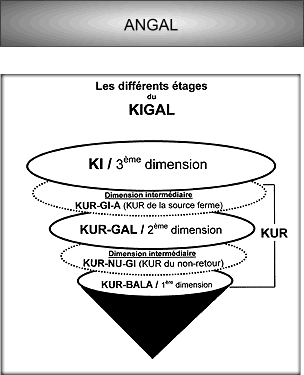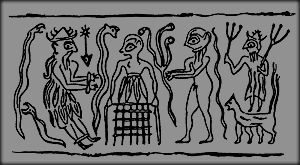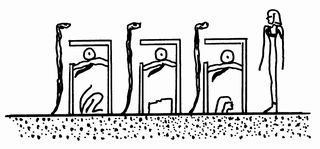|
THE CHRONICLES OF THE GÍRKŮ / Notes (2)
Dimensions
 (KIGAL graphic taken from Ádam Genisiš) Parks' system of dimensions is much more complex than the simple "stacking of planes" found in many metaphysical descriptions of reality. However, with frequent references to the graphic, everything should fall into place for you. In his description, which he ascribes to the "secret ideology of the Gina'abul," the highest level -- actually a system of dimensions itself -- is called the ANGAL, or Great Heaven. The ANGAL is home to the Kadištu races, where most of them evolved. Most, but not all. The Ama'argi did not, nor are the ANGAL dimensions natural to the personages Nammu and Sé'et, though all of these are counted among the Elohim, which is to say Kadištu. Parks refers to the lowest of the ANGAL levels as the "fourth dimension". The Amašutum can move about on this level, but can go no higher. The dimensional system known as the KIGAL (Great Earth) is composed of the KI, our "3rd dimension", where we evolve on the Earth, and the KUR, which encompasses lower dimensions. The KI is home to the Ama'argi and the Urmah (another Kadištu race), as well as Nammu and Sé'et. Parks is not certain, but he suspects the Urmah also have access to Angal frequencies. These levels are to some extent specific to the planet. Thus "KI" as referenced in Le Secret, the dimension on which Gina'abul and Urmah evolve, is not the terrestrial KI! It corresponds to Earth's KUR-GAL. The KUR, which is invisible to the three-dimensional perception of beings evolving in KI, consists of KUR-GAL, the 2nd dimension, and KUR-BALA, the 1st. This KUR is the region promulgated as "Hell" by the Judeo-Christian religions and, as such, it evokes images of a dark and lugubrious domain. However it is none of that! It is similar to our 3rd-dimensional world with its mountains, lakes, forests and deserts. On the other hand, its light is different, as are the sensations there. As can be seen in the diagram, the KUR also includes two intermediate dimensions. Just "below" our 3rd dimension is the intermediate dimension KUR-GI-A, meaning KUR of the "firm" Source, or the ANGAL. This implies an interlocking: whereas the system of dimensions lower than our 3rd is for us "the KUR," the ANGAL has its own KUR, and that is the KUR-GI-A, which is one of the intermediate dimensions in our own KUR. The decomposition of the word KUR, incidentally, suggests "belted or banded foundation," or "base of the foundation." Decomposition of the term KUR-GI-A reveals that this is a transitory dimension in which souls rest momentarily before reintegrating with the Source or ANGAL. Just below the KUR-GI-A is the KUR-GAL (2nd dimension), "the Great KUR," a parallel world where certain Gina'abul took their residence on planet Earth (as will be related in later volumes of the series). Below that is inserted another intermediate dimension, the KUR-NU-GI (the KUR of no return). This is the level of "lost souls" - the place in which entities are marooned; we know them as ghosts. To the Sumerians, KUR-GI-A and KUR-NU-GI were two versions of hell. The 1st dimension, KUR-BALA, is the "lowest" of them all. The Sumerians and tablet specialists liken this place to "the beyond," but the exact meaning of KUR-BALA is "the KUR of the realm or kingdom or dynasty." On Earth, the KUR-BALA was the object of numerous hostilities among the Gina'abul, because whoever holds the KUR-BALA becomes inevitably the master of the KUR-GAL and the KI.
All-Seeing Eye views KUR-GAL and KI only. The master of the KUR-BALA is literally "the all-seeing eye at the summit of the pyramid... inverted," because it looks directly onto the KUR-GAL and the KI! That is why on the tablets KUR (or KUR-BALA) is often translated as "enemy world," a place where chaos seems to reign perpetually. The first three dimensions form a sort of inverted pyramid with KI representing the base and the dimension KUR-BALA forming the pinnacle. People have been led into confusion over this "pinnacle" geometry, as it reflects the dimensions above KI (the ANGAL). These function somewhat the same way, but in a manner inverted from the KUR or KUR-BALA. The higher one climbs in the ANGAL, the more one possesses a global view of the ensemble of all the dimensions. The inhabitants of the lower dimensions can appear quite powerful, but they are actually limited and are inferior reflections of beings in the ANGAL.
The term KUR is found abundantly on Sumerian tablets that relate a pitifully small and ridiculous part of the history of the Gina'abul. Specialists in the Sumerian tablets give to KUR several attributes, such as "lower world", "hell", "country", "mountainous country", "mountain", even "unknown country". In the eyes of ancient-orient experts, the definition of the Sumerian KUR seems at once complex and difficult to grasp because they do not conceive of a world formed of dimensions layered on one another. In the Sumerian mythology KUR is most often taken to designate either "a mountainous country" or "rebel countries". But it is clear from the tablets that the KUR is a transitional place between heaven and earth, a secret place where the "gods" live unknown to humans.The Gina'abul possess a spherical instrument known as Gúrkur (see Decoder), which enables them to pass among all the dimensions of the KIGAL. But Sa'am discovered that the Mušgir have the inherent ability to transition these dimensions without recourse to any technology. This enabled a million of them to hide in the lower dimensions and escape the cleansing at the end of the Great War. They later became part of An's armed forces.
On the Sumerian tablets the verbs that express a movement toward or away from the KUR are E11, which manifests the act of descending, climbing, going out or returning to the KUR; and U5, which expresses the idea of voyaging or navigating to the KUR. The latter reinforces the concept of a land foreign to the human dimension (KI) toward which the Anunna-Gina'abul were able to transport themselves with the aid of a Gúrkur, but also the idea of heavenly embarcations as with the Kadištu on Duků which will be explained in my presentation of these events.What is the nature of this "land?" Parks describes it (above) as having mountains, lakes, forests and deserts. But what is it? A sort of dreamland, from our perspective? Parks has, in his "total immersion memory," at least one adventure into the KUR that would suggest a more tangible reality to it. Shortly after receiving his Gírků, Sa'am makes a literal leap into the KUR-GAL, and immediately drops about forty feet to a different terrain that happens to be that far below the one on which he had just been standing! And this is not unreasonable. A different landscape is going to have different elevation features. Who is to say that one moves automatically to the surface level when changing dimensions?The implication is that Sa'am moved to a different planet but retained the same position in spherical coordinates (or any three-dimensional coordinate system) with respect to the new one as he had occupied before on the old one. Or that the two planets were centered on the same point in a higher-dimensional space. That is perhaps reaching, but it may be the simplest solution to the problem. This idea is further supported by the discovery that he could still see the previous surroundings, superimposed on the new ones. Specifically, he had been in a kind of gruesome battlefield graveyard; he was now under the bodies in it! The point is that there was a stable geometrical relationship between the two locales. Furthermore, when he next went to the KUR-BALA -- the "first" dimension -- he could now see all three! Although this was disconcerting, it does explain why Parks has said that those positioned in the KUR-BALA have great power over our world. Shall we ask whether these were different planets or one planet with different aspects? Or is the answer just a matter of definition? While it may be simply a matter of how one defines it, the suggestion is that there are rich influences taking place between the various levels -- though we are not directly conscious of them.
In the second work of this series, we will make frequent reference to another Kur (written in lower case to distinguish it from the dimension KUR) which has the sense of "mountainous or hilly" or "high plateaus". This region, also called Dukug, is the mountain where the Celestial Bestiary is established in the surroundings of the Mesopotamian plain.
ClonesTo Be a Clone
"I remember well this first impression, this painful sensation of crushing and suffocation. My spirit was empty and invaded with uncertainties. How had I arrived here? What mission had I been given in incarnating into this body in distress, at the edge of asphyxiation? Totally numbed, I opened my eyes and observed the artificial womb in which I was buried. By all evidence, my body had arrived at its finish, its termination."Of course it had not arrived at its finish. It had arrived! Just about one of our days earlier, it been only a fertilized ovum. Cloning is one of the edge technologies of our age. We have seen cloned animals; human clones would appear to be within reach; the ethics of the practice have us stumped for the moment but can there be any doubt that it will be done, perhaps on a massive scale, or even is already an accomplished, though covert, presence in our world? We wonder what a cloned human would be like. Would it come into the world from a natural or artificial womb, like any natural newborn baby? Would it have a consciousness like that of any natural person? Would it be like a twin to whatever human contributed its genes? Would it be born with that person's knowledge "wired in?" Parks, due to his mind-meld visions, has answers to these questions, and provides them amply in his book. From the Karmapolis [K1] interview: The Gina'abul knew how to program the genes of an individual to give him such or such character or physiognomy. They could determine in advance and even program like a computer the body of knowledge of the specimen they were fabricating.1 For that, they utilized crystals and notably various types of quartz. But I cannot say more of this because I am opposed to these procedures that seem to be totally immoral today. The story that I relate is filled with genetic manipulations and I know well where they led the Gina-abul and above all the human species.Recall from Carlos Castaneda's The Active Side of Infinity: "In order to keep us obedient and meek and weak, the predators[here Gina'abul] engaged themselves in a stupendous maneuver - stupendous, of course, from the point of view of a fighting strategist. A horrendous maneuver from the point of view of those who suffer it. They gave us their mind! Do you hear me? The predators give us their mind, which becomes our mind. The predators' mind is baroque, contradictory, morose, filled with the fear of being discovered any minute now." In the opening pages of Part 1, we are treated to the stream of consciousness of a cloned adult Gina'abul, awakening within the glass womb, and after moments of sensations of suffocation, disorientation, and confusion, coming to his senses, recognizing his "father-creator," having a brief conversation with him, and then hopping into his personal craft to embark on a worlds-shaking mission. The brief conversation was critical. If he had turned out to be a perfect clone in terms of his identity, his father would have destroyed him without hesitation, as he had done others. His father had been aiming at something different: a prototype of a new race. This one turned out to be a success. This is Sa'am, a personage from birth, the protagonist of the book, whom we will come to know deeply. His father-creator is named An; Sumerian scholars know who he is; Sa'am is unfamiliar to us, but we will eventually recognize him as well. An is also a clone, and a Great Lord, the "Seventh of the Ušumgal."
 The emerging female is Eve. Sa'am is at left. Who Clones Sex having been banned for a long time, the Gina'abul procreated with the aid of genetics, which produced all sorts of specimens and hybrids to which belong for example the Měmínu (Greys) who are but slaves in service to the male Gina'abul.
Having mutually disconnected themselves, the female reptilians and certain males specialized in cloning. A little later, the Amašutum joined with the Kadištu of our universe. They have always been wiser than their masculine brothers and without doubt it was for them the best means to redeem certain past errors. In one of the opening chapters of Le Secret, Sa'am travels to Unulahgal, the capital of Nalulkára, a place he describes as "the blessed, the jewel of our proud planet." And a beautiful city it is, but that is for another part of our discussion. Unulahgal was... ...the center of the great initiates. All the "Life Designer" priestesses studied in this high place of apprenticeship. By their own dogma, they were the miracle workers of life, the great transformers at the service of the Original Source -- the primordial and universal Divinity. A few of them had the privilege of planning life on the planet Uraš (the Earth), situated in the prodigious stellar system Ti-ama-te (the solar system). The enigmatic doctrines of the priestesses and the Kadištu (Life Designers) were terribly feared by the males of our race [the Gina'abul].This is a devastating statement! A key reason for having this entire treatment of Parks' work on our website. In these few words, Parks sets before us a vision of the secret of life as we know it. In our day, the eternal schism between "evolution science" and "creationism" has spawned "intelligent design," at its best an unabashed study of the critical role of molecular biology in the propagation of living species, but ultimately an embarrassment as it argues for "God" as the molecular biologist. They are correct in seeing the tracks of someone with high intelligence at work on our molecular machinery but they could not envision who that might have been... or they forced their own religion onto it. Now Parks gives us something quite acceptable: an entire city of designers -- apprentices, students, and accomplished ones -- working under the inspiration of the formless Kadištu, themselves in service to Divinity. This arrangement, mind you, is not offered as the source of all life everywhere. The many worlds of the Gina'abul are scattered at some distance from here (see Worlds), but they are not infinite in number and we can see from here all of the constellations in which they reside. So this is a small grouping, surrounded in the vastness by what? We don't know.For the discussion in Open SETI that ends where this vision begins, see Challenges to Darwinism - Panspermia and Theories of Guided Evolution.Here is Parks' discussion of the various Gina'abul who have the capability of cloning: The Kingú-Babbar (albinos) know how to clone; they are even great experts. They are the creators of the Ušumgal!Parks also mentions in his second book and in the Karmapolis interview [K2] that the dinosaurs (Hušmuš) were the result of genetic experiments practiced by the Kingú before the Kadištu gave them permission to "officially install themselves" on the Earth. Parks also believes [K2] that certain types of "peaceful" dinosaurs were created by various Kadištu. Generally speaking, the male Gina'abul are clumsy at cloning. For that reason they use the Amašutum. The Amašutum possess the power of creating. They possess the complete genetic patrimony, the gift of the Gina'abul colonies of Margid'da (Ursa Major) in their genetic banks on their mother planet Nalulkara. Asked about the apparent autonomy of the Greys with whom we seem to be in contact today: As much as they seem autonomous today, that was not the case millennia ago... All that is strange. Frankly, I think they are not genuine and they play a manipulative game. In fact, I think that they are always directed by the Kingú-Babbar who are in conflict with the Anunnaki and their descendants. I have difficulty seeing the Kingú-Babbar liberating the clone-slaves that they have possessed and used since the night of time!Readers will note that this issue of the meaning of what appear to be cloning or genetic manipulation activities on the part of "Greys" and others, comes up again and again on the pages of Open SETI and The End of Enchantment. Genetic operations, either real or attempted or simulated, are apparently of vital importance to these various races, and may well be to ourselves, however little attention they have been given by the public. Not all the races known to Parks propagate by cloning or by being cloned. One that procreates "naturally," raises children, etc., is the Imdugud (see Races).
|
 The Gina'abul have possessed for many thousands of years the knowledge of cloning. One can trace this knowledge on the representations in clay of Mesopotamia, the Codex Mayas, or even certain Egyptian figurines such as this one (at right) in the tomb of Thutmosis 3 in the Valley of the Kings.
The Gina'abul have possessed for many thousands of years the knowledge of cloning. One can trace this knowledge on the representations in clay of Mesopotamia, the Codex Mayas, or even certain Egyptian figurines such as this one (at right) in the tomb of Thutmosis 3 in the Valley of the Kings.